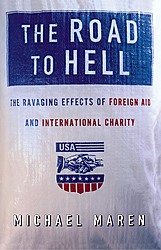
It wasn’t as if domination was their manifest purpose. They claimed they were there to help. And some of them believed it. The objects of their assistance were underprivileged and backwards, nobly trying to grasp the concepts of a new era but disastrously unable to do so. What they needed was the golden touch – the magnanimous muscle of giants born into privilege.
I speak, of course, of foreign aid. Or maybe old world colonialism. The similarity between the two is a theme woven throughout a groundbreaking narrative by experienced aid worker Michael Maren entitled, The Road to Hell: The Ravaging Effects of Foreign Aid and International Charity. Maren’s experience in Somalia with development giants USAID and Save the Children revealed to him a profit-driven industry rife with corruption and largely unconcerned with the humanitarian ideals it trumpets.
THE IMAGE OF AFRICA
Private donations – and public policy, to a large extent – are heavily influenced by a shared conception of Africa. A pitiful child with a protruding ribcage and flies on his face stares longingly into the television, while soothing voices offer a solution at the low price of 35 cents per day. As Maren puts it, “The goal [of aid programs] is not to make us think about hunger and poverty. It is to relieve us of the burden of having to think about it.”
The image of the “starving child” was actually conjured by marketing wings of aid organizations.
The image of the “starving child” was actually conjured by marketing wings of aid organizations. Such imagery makes a blatant appeal to the paternalism of Western culture. It is natural for westerners to view Africans as helpless victims in need of our benevolence. Media portrayals confirm this image. Few question whether those portrayals are accurate. Even those who are able to look past Sally Struthers’ pleading voice and the emotional resonance of a picture of an emaciated child accept the veracity of regional newswire accounts. But as reports of famine grow, public alarm gains momentum and compels reporters to forsake journalistic integrity for the purpose of their own story’s inertia. The size and condition of vulnerable populations is rarely clear or verifiable. As Maren points out, estimates of refugee numbers in Somalia were largely overblown, perhaps tripled. Refugees in Somalia were not the helpless, starving pictures of pity they were portrayed to be, but often lived higher quality lives than the general population. In fact, the call to moral action made by the media leading up to U.N. and U.S. intervention in Somalia was made at a time when overall conditions in the region were actually improving.
Aid workers tell of being driven to remote pockets of the countryside to take pictures of the proverbial starving children for marketing purposes. Preparation for leadership roles in development corporations involve education on how to “sell the children.” Those marketing campaigns ignore the simple truth that many afflictions plaguing refugees result from their prolonged presence in the camp rather than famine. In Somalia, it was in the interests of all parties involved to perpetuate the refugee crisis in order to continue to draw aid money.
Famine is not a new phenomenon to Africa. Timeworn systems had been in place to cope in such times, such as contingent agreements between nomadic and agricultural peoples to assist each other during their respective successful and difficult periods. Although attempts to portray pre-UN Africa as a utopia are misguided, African states resided much closer to self-sufficiency before the deluge of foreign aid. Why, then, do aid nonprofits persist?
BIG BUSINESS
Aid organizations would have their donors believe that 90 cents out of every donated dollar is used to feed those adorable emaciated children. The exact claim is that 90 percent of donations go to “programs.” Their dirty little secret is that “programs” can include marketing, machinery, stipends, SUV’s for aid workers, and $300,000 salaries for development company CEO’s. The aid industry is plagued with too little oversight domestically and too much bureaucracy and corruption abroad. Favor trading at the source and destination taints fair distribution of resources. Massive amounts of aid are funneled into giant funds with little regulation as to its dissemination. NGOs (Non-Governmental Organizations) know what to say to secure funding; they are experts on buzzwords of the day. The latest buzzword is “sustainable development,” a term that is vaguely redundant and almost never clearly defined. Rarely do development projects fit into a long-term plan, nor take into account sensitive social and economic factors of a given region. Agriculture and irrigation projects are carried out without regard to greater environmental concerns. Free-market practices are forced upon formerly socialist societies like square pegs jammed into round holes.
Maren describes how development workers flooded Somalia in the years preceding the U.S. intervention. They were mostly young and inexperienced. Some were given responsibilities far beyond their means to carry out. Few aid workers connected with the populace on any meaningful level. Their access to good housing and food made them objects of resentment among Somalis. Amazingly, little thought was given to the conceptions that natives might form about development workers, nor any other aspects of the program.
Sometimes the misallocation of aid funds is unintentional, as when lucrative black market deals divert food and cash. Other instances are less innocent, however, as when the United States, under the pretense of humanitarianism, knowingly supplied food and money to the forces of Somali dictator Siyaad Barre. The transgression was later explained away as a cold war gambit.
The introduction of money and other resources alters the dynamic of a region. Some honorable members of the Somali government noted that, in their country’s case, aid created dependency and decreased motivation to return to a normal lifestyle. Authoritarian regimes capitalized on that dependency: as long as aid passed through their networks, they maintained a stranglehold on the country. Meanwhile, development companies, their suppliers, and their distributors grew rich buying cheap and selling at prices far above fair market values. What resulted was an incentive to perpetuate and overstate the refugee situation for as long as possible. Everyone benefited. Everyone except U.S. taxpayers and the Somali people.
SIMPLE SOLUTIONS TO COMPLEX PROBLEMS
Reporters are too quick to dramatize “tragedies” in Africa, crises that have always manifested in the ebb and flow of climate change and social movements. Aid organizations bring these perceived atrocities into our own living rooms, implicitly promising relief from any emotional nuisance the images cause. Officials in those organizations reap most of the benefits of their massive fundraising efforts. Opportunists in Africa climb out of the woodwork to take advantage of the incoming funds. Idealistic college students flock to the exotic tropical climates of Africa in search of a moral high.
For the paper-thin logic of foreign aid and development to be so eagerly bought and sold, and at such high prices, requires an overly simplistic worldview shared by all unknowing parties involved. That worldview includes the arrogant belief that well-meaning but inexperienced college kids can somehow provide salvation to cultures and societies mired in social, racial, and economic crisis. The belief that food and cash alone will solve a region’s problems is even more ridiculous.
Maren asserts that food shortages were not an issue in Somalia-that famine, at least in that instance, resulted from both intentional and unintentional misallocation of resources. Little consideration is given to the deep, complicated, and interwoven factors embedded in the fabric of struggling societies. As long as poorly regulated food aid and development programs continue to comprise the normal response to social problems in the third world, suffering and artificial famine will endure. Of course, there is no reason to believe that the powers that be will have a problem with that.





No Comments so far ↓
There are no comments yet...Kick things off by filling out the form below.